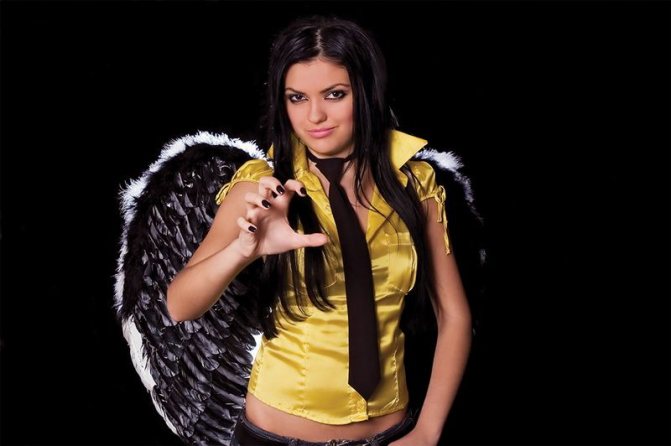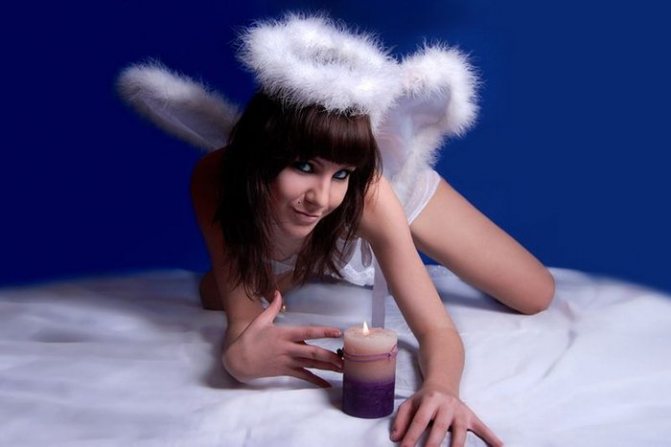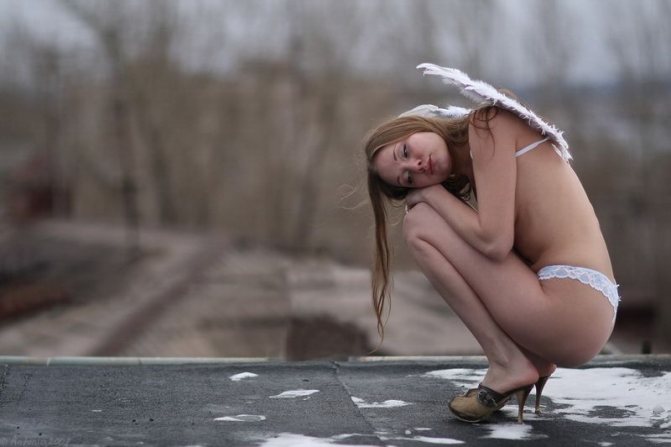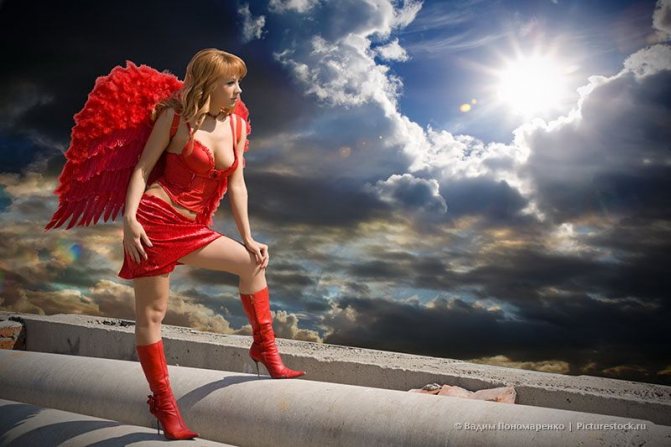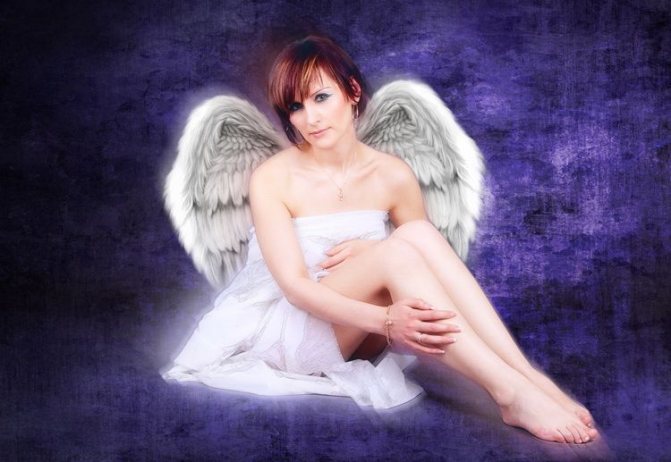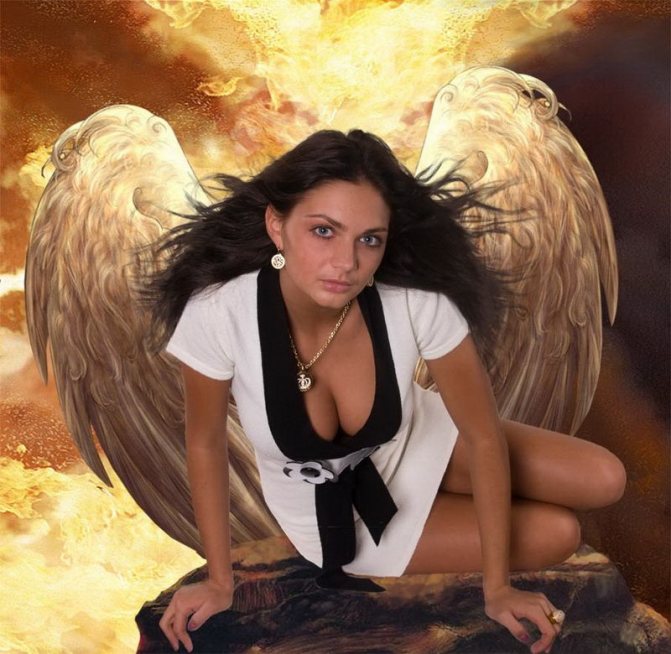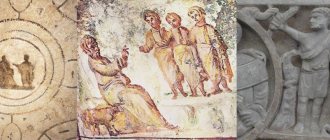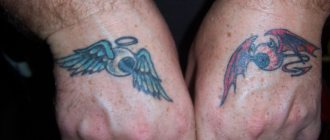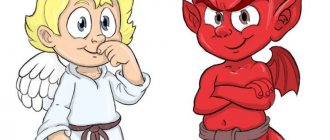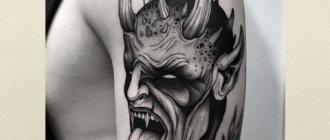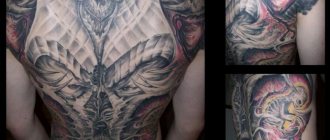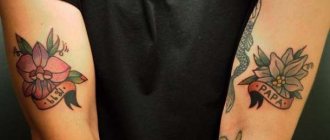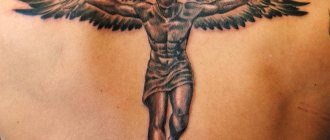«
Brevity and riot of colors, tenderness and passion, fusion of styles and eternal struggle of opposites - all this came together in our photo shoot!
»
Save Saved

Save Saved


Save Saved


Where did the devil come from?
But even if we narrow it down and consider only the image of Satan, clearly separating him from other evil spirits, new difficulties arise. The fact is that there is no description of the devil's appearance in the Bible, and artists had to "invent" it themselves. In addition, in the Old and New Testaments, the father of evil appears in very different contexts. For example, in the Book of Job he is rather an opponent of God than His sworn enemy. The Book of Isaiah mentions Lucifer, who was cast down by God from heaven for his transgressions (but the name Satan is not used in reference to him):
"Into the underworld thy pride with all thy noise is cast down; beneath thee the worm is bedded, and the worms are thy covering.
How thou hast fallen from heaven, O son of the dawn, thou shattered upon the earth, thou who trampled the nations."
(Isaiah 14:11-12).
Finally, the Book of Ezekiel describes the king of Tyre, who at first "was in Eden, in the garden of God", "was anointed with the cherubim", but after "iniquity was found in him", he was cast down by the Lord "from the mountain of God" (Ezek. 28: 13-16).
In the New Testament, the devil no longer just argues with the Creator, but also tries to harm him-and even suggests that Christ become his servant:
"Then Jesus was led by the Spirit into the wilderness to be tempted by the devil, and, fasting for forty days and forty nights, at last he was hungry.
And the tempter came to him and said, "If you are the Son of God, tell him to turn these stones into bread.
He answered, "It is written, 'Man shall not live by bread alone, but by every word that proceeds from the mouth of God.
Then the devil takes Him to the holy city and sets Him on the wing of the temple,
And he said unto Him, If thou be the Son of God, cast thyself down: for it is written, He shall command His angels concerning Thee; and in their hands they shall bear Thee up, lest Thou dash Thys foot against a stone.
And Jesus said unto him, It is also written, Thou shalt not tempt the Lord thy God.
Again the devil takes Him up a very high mountain, and shows Him all the kingdoms of the world and their glory, and says to Him, "All this I will give You, if You fall down and worship me.
Then Jesus said to him, "Get away from me, Satan, for it is written, 'You shall worship the Lord your God and Him alone shall you serve.
Then the devil leaves Him, and behold, the angels come and serve Him.
(Matthew 4:7-11)
For the first time these disparate images merged together in the Vulgate, a Latin translation of the Bible, made at the turn of the fourth and fifth centuries by Hieronymus of Stridon. In it, Jesus Christ Himself is named as a witness to the fall of Lucifer the Dentist from heaven.
Jerome combined at least four different characters in the figure of Satan because he relied on the interpretation of the theologian Origen. He compiled the information contained in both Testaments about the antagonists of God and presented a monolithic image. Thus Lucifer the Denniel from the Book of Isaiah, the fallen king of Tyre from Ezekiel's prophecy, Satan the disputant from the Book of Job and the devil from the New Testament became one and the same embodiment of absolute evil.
Angels in video games
Biblical themes are an integral part of Western culture. They are a source of inspiration for many generations of artists and writers. Not surprisingly, the image of divine messengers has not escaped the notice of video games. Let's see how angels are represented in some popular games.
Diablo game series. Angel on guard of humanity.
In 2000 the legendary Diablo 2 was released. One of the key characters in this RPG was the archangel Tyrael. The game's popularity and impressive design made him the most famous angel in the world of gaming.
The laws of Heaven do not allow him to directly intervene in the struggle of humans against the forces of evil. More often than not, Tyrael acts as a bystander or provides indirect assistance. Although the player does not see manifestations of the angel's power, there is no doubt of his power. What makes Blizzard's design of the archangel so interesting?
1 Tirael's face is hidden in the shadow of the hood. This simple but powerful visual device adds mystery to the image and makes it impossible to unequivocally identify the archangel as a creature of flesh and blood, despite the anthropomorphic nature of the figure. The player can only look into the angel's eyes after he has become mortal.
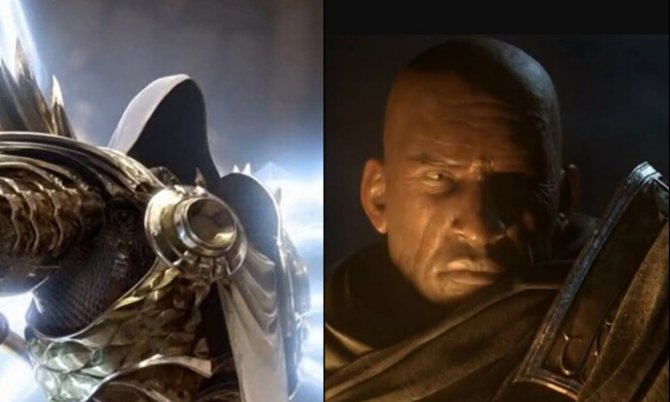

The face is the first thing the human gaze looks for. This skill, acquired in the course of evolution, allows one to identify emotions by facial expression and quickly develop a response. Archangel gains a face, but forfeits immortality.
2. Tirael wears a golden armor that resembles 15th century Gothic armor. Archangel does not participate in battles, but the player has no doubt that he is a warrior. His armor is covered by a tabard, a piece of clothing that, like the hood, resembles the robes of medieval monks.
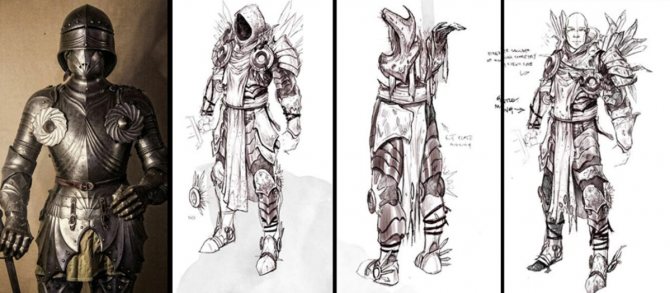

Gothic armor is easily recognized by the many sharp corners. After Tirael's exile, the armor lost its luster and became shabby.
3. A striking and memorable feature of the image was the unusual wings. Blizzard designers have modernized the historical concept - Tirael's wings look like waves of shining light and are intangible in nature. To help the viewer understand that they are really wings and not tentacles, there is an armor element in the form of feathers at their base.
Tyrael's wings are made of energy and have no feathers. Nevertheless, this does not prevent one from recognizing him as an angel because of his recognizable silhouette.
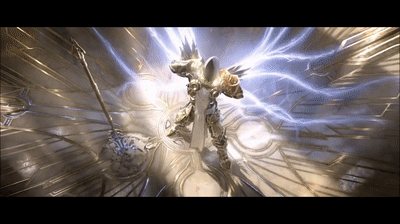

Going against the will of the angelic council to save humanity, Tyrael becomes an exile. He is stripped of his power and wings.
Tyrael's appearance became the basis for the rest of the angels Diablo 3 offers. The continuity of the design makes it easy to place them in the same faction. Nevertheless, each archangel has unique features of appearance corresponding to the aspects of the universe - valor, justice, hope, destiny, and death.
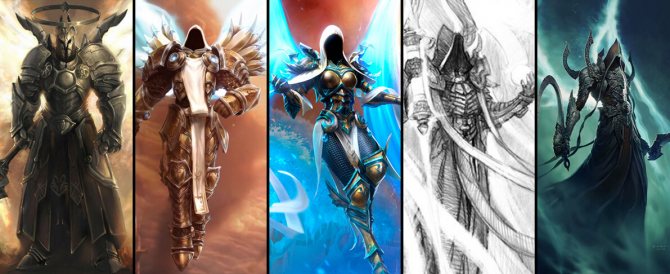

From left to right - valor (the primacy of this aspect is emphasized by the massive halo; heaven and hell are at war), justice, hope, wisdom, death.
An ancient race in the Heroes of Might and Magic series of games
Angels first appeared in HoMM III, released in 1999. They are powerful fighters, capable of resurrecting fallen comrades-in-arms and dealing massive damage to demons. The concept artists were inspired by the classics when working on the third installment. The bearded and curly-haired archangels are reminiscent of Greek warriors in ancient armor, with anatomical visor, leather pteruges and distinctive greaves. The angels are dressed more simply, in a Greek chiton. They are armed like the warriors of medieval Europe: a two-handed flamberg, a sword and an English shield.
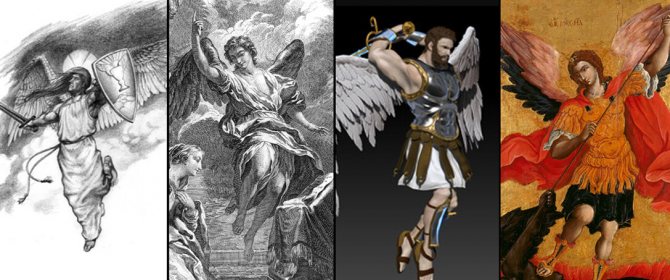

The angels and archangels (the first and third images) were created based on the classic image.
The angel outfit of HoMM IV is a strange mix of armor from different eras. The angel's torso is covered by an antique cuirass, and a chain mail is worn underneath, which also protects his head. If chainmail was known before Christ, the shoulder pads, cuots, greaves and sabatons are obviously taken from the armor of medieval knights.
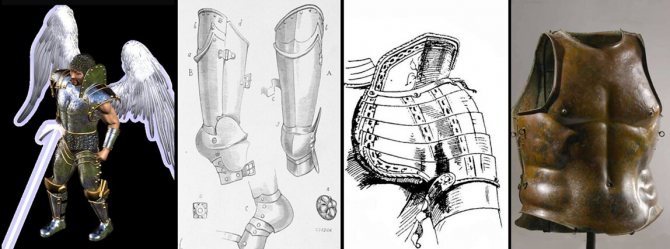

In Heroes of Might and Magic 4 the angel outfit is assembled from parts of ancient and medieval armor.
The fifth part of HoMM, released in 2006, laid the foundation for the appearance of the rest of the angels in the series. They are blond creatures with huge wings, dressed in a long monk's dress and armor. Armed with a huge sword worthy of an anime hero. It's possible that the idea of hiding the face of an archangel (the second step of unit development in the game) under the hood was borrowed from Diablo 2.
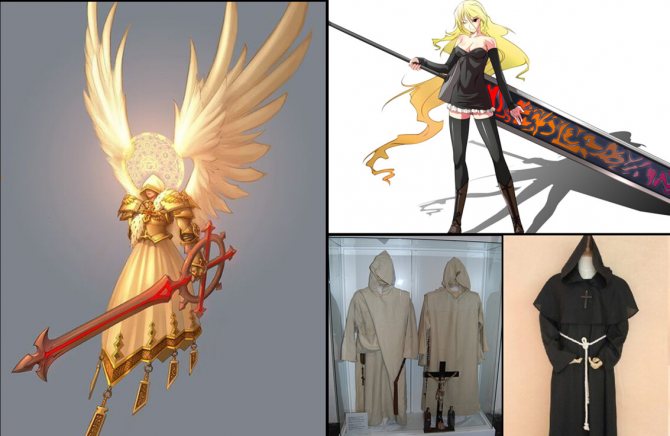

Although Elrath's angels are not Christians, their image is complemented by crucifixes (the cross around their necks and the distinctive shape of the sword's guard).
The next installments of HoMM adhered to the concept. Improvements to the graphics engine made the textures and patterns on the armor, sword and dress more interesting. Angels began to be positioned as a biological species capable of aging and multiplying. They also acquired negative traits - one of the heroes of Part VI even uses dark magic for revenge.
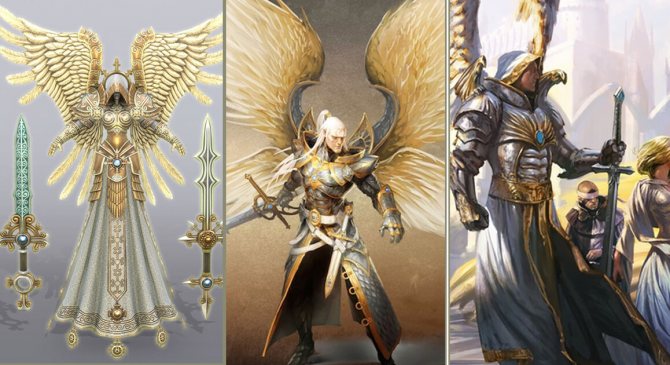

The leader of the angels (in the center) has an extra pair of wings to make his silhouette different from ordinary fighters.
Darksiders. If Angels Came Down from Heaven Today
An unusual take on angels is offered by the Darksiders series of games. While past games have presented them as mighty fighters who can crush dozens of monsters on their own, in Darksiders angels are ordinary "mobs". The main character is far from a mere mortal, so he fights and interacts with them as equals.
The game was designed by Joe Madureira, the famous comic book artist of the Marvel universe. The angels in his concepts are several heads taller than humans and look like cyborgs with feathered wings. The thickness of the armor and the chopped curves of the armor plates look like they were made in an industrial factory. This gives their image a touch of futurism.
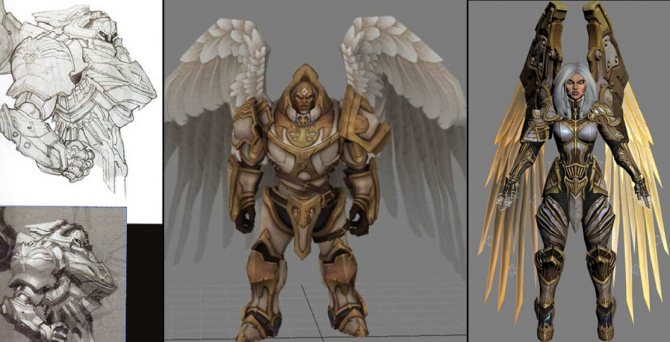

The action of the game unfolds in the modern world. Medieval armor would be inappropriate in such circumstances.
By creating a concept that differs from the traditional one, the artist should keep it recognizable. The main attribute of the angel's appearance that forms the characteristic silhouette is the feathered wings behind his back.
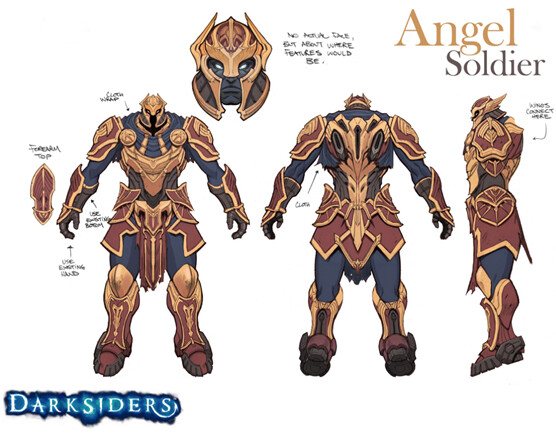

Darksiders angel, devoid of wings, could well be armed with a blaster and become a fighter in a sci-fi-themed game.
Blue Angel and Black Man: The Anthropomorphic Devil
Not surprisingly, the first images of the "father of lies" were created based on his recently established "biography. Art historians have discovered that the oldest surviving image of Satan is on a mosaic in the Basilica of Sant'Apollinare Nuovo, built around 520. On it we see the Last Judgment, in which Christ separates the lambs from the goats. At His right hand is an angel with a red halo. Next to him are the obedient sheep, representing the righteous. But to the left of the Lord, above the goats (these animals often grazed away from home, wandered into the mountains - and therefore became a symbol of lost souls), is an angel with a bright blue halo.
He does not look monstrous, but his location next to sinners and the unusual, opposite to the "right" color of the glow around his head make us think that this is how the artist wanted to show the image of the fallen angel, that is, Satan.
Since the canons of the iconography of the devil were not yet established in late Antiquity, the author of the drawing largely improvised, trusting in his own imagination. The presence of a nimbus on a negative character should come as no surprise: later, in the Middle Ages, demons, the Antichrist and the apocalyptic beast were depicted with a halo around their heads. This graphic element served as a marker not only of holiness, but also of supernatural power in general, and sometimes as a compositional device. In addition, the author could depict Lucifer before his fall - and in this case quite skillfully conveyed the angelic nature of the character, without in any way violating the truth.
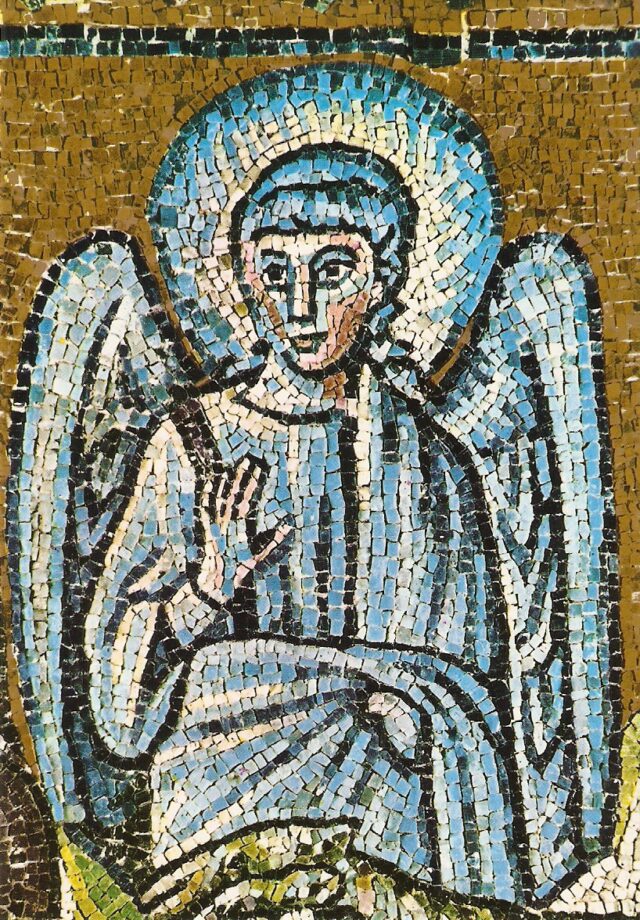

In one of the oldest monuments of Christian iconography, the Gospel of Rabula, created in 586 in Syria, in the healing scene of the Savior possessed, we find the first known image of the demons. It is not Satan himself, but later his minions will usually bear at least a remote resemblance to their master. The demons of Rabula's Gospel are red winged creatures resembling angels. So it is difficult to say definitively how people in that era imagined the devil, especially since European art takes a pause of three long centuries at this point.
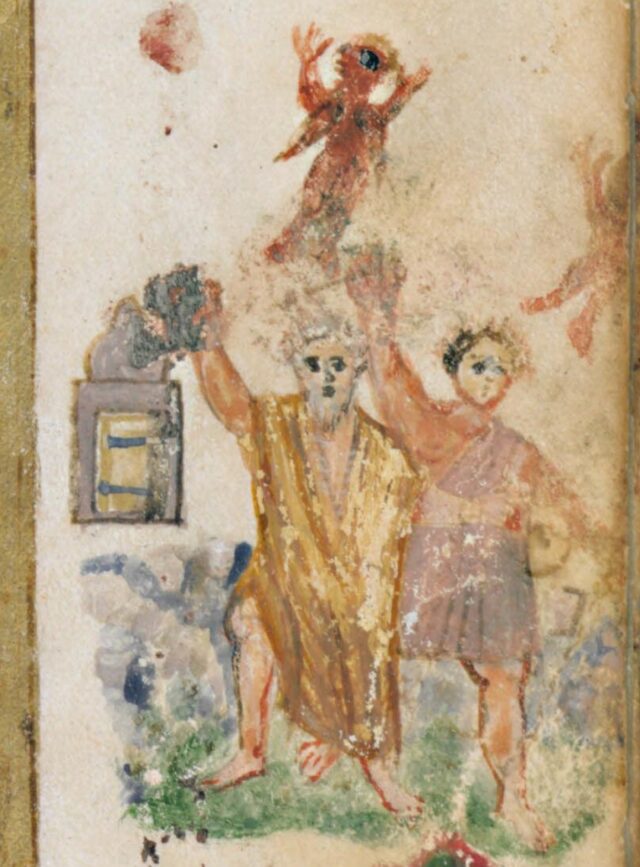

In an eighth- or ninth-century Bible, now preserved in the Vatican Library, Satan, addressing Job, is depicted as a black wingless man. He is naked, but his thighs are covered with a bandage, and he has blue boots on his feet. The devil holds in his hands a large staff, with which he apparently intends to torment Job.
The Enemy of the Human Race only began to be painted en masse in the ninth century. In the Stuttgart Psalter, written around 820-30s, we find not only numerous images of demons, but also a detailed depiction of the devil himself seducing Christ in the desert. At the same time, the demons and Satan are almost exact copies of each other: they have dark bodies, disheveled hair and beards, hellfire often bursts from their mouths, and they are usually winged (an allusion to the breed of fallen angels).
The demons sometimes have snakes crawling all over them, and in the images at the end of the manuscript their normal human legs begin to mutate into monstrous bird's feet.
The devil, who is at the top of the infernal hierarchy, has a staff in his hand, a sign of power. Until the eleventh century Satan would be depicted as a dark anthropomorphic creature with wings-no animal ears and paws, claws and horns or numerous jaws. All this shows that the "biography" of the lord of darkness was well known. He was stripped of his elegant angelic robes, his body color was changed from the noble white to the black despised in Europe, and his face and hairstyle were made less pious.
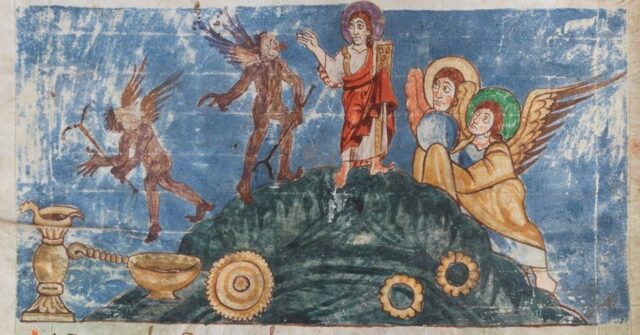

In the Christian East at the same time, the iconography of the devil might have been quite different. In the Church of St. Barbara, now in the open-air museum of the city of Göreme in Cappadocia, an unusual 9th-century fresco depicting - as many art historians believe - Satan in the form of a locust has been preserved. During the iconoclastic era, non-ornamental illustrations were forbidden in this region, and so churches were full of crosses, squares, circles, and plants. Locusts are one of the images of the Apocalypse, traditionally associated with evil. In a region not unfamiliar with this insect, the negative connotations may have been even stronger. In Western art, however, the devil did not begin to acquire animal characteristics until two centuries later.
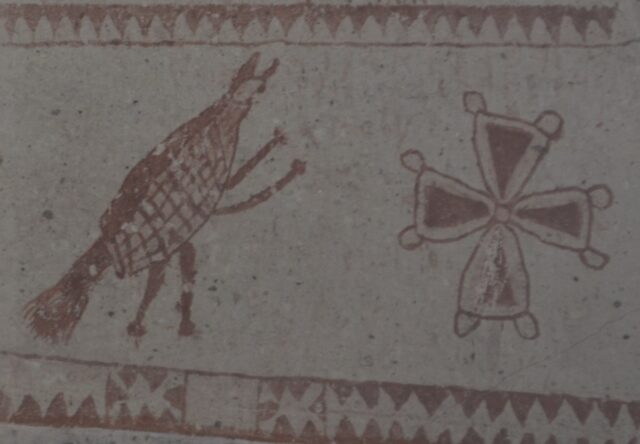

Goat-footed and dog-headed: the animal devil
At the beginning of the 11th century, the image of Satan in European culture changes dramatically and begins to vary quite widely. For example, in the Barberini Psalter, created around 1050, in the same scene of Christ's healing of a possessed man, there are not only demons flying out of the man's mouth, but also Satan himself, defeated and restrained by the Savior.
It is a half-naked zooanthropomorphic creature with a red body, gray hair, bald hair, and a muzzle resembling that of a dog.
In a 11th century English manuscript the Devil appears in a completely different guise: he is shown as a giant with a hairy back (texts of the time compared his hair to tongues of flame) and a disheveled hairdo, without a single animal trait. On the other hand, it is not so easy to see anything human in the figure of Satan from a Spanish commentary on the Apocalypse (11th century) - the character's legs and arms have sharpened claws and look more like animal paws, a short tail protrudes from his rear, and his nose resembles a beak. This last detail is not accidental - at that time, Jews were depicted as ugly and nosy, and the author probably intended to draw this visual parallel. Black, gray, brown, blue or purple, Satan with his colors of night and disease was opposed by the red or white angels who embodied the heavenly fire and light of God.
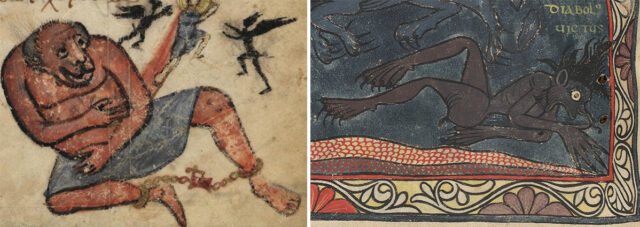

In the same century, some devils develop horns. Tiny at first, they later become the dominant image. Together with claws, animal ears and paws, a tail and, since the 12th century, bat wings instead of angelic ones, these details shape the image of the devil throughout the Middle Ages. The "beastification" of Satan seems perfectly logical: how else could artists portray the base nature of the enemy of the human race, who had fallen from heaven?
Horned, tailed, goat-footed and hairy, the devil sometimes resembled the ancient god Pan to such an extent that some scholars speak of a continuity of images (while others believe that Satan "descended" from satyrs, jester-athletes and the winged Eros in Greek vase-painted images). And they explain it this way: in Antiquity, when the new faith was just beginning to spread through the Roman Empire, evil became associated with the old, pagan pantheon. Christian theologians never tired of repeating that by worshipping statues of traditional Roman celestials, people were honoring Satan himself. They especially denounced those of them whose cults were associated with promiscuous rites, such as Pan, who stood out for his indecent behavior and bestial appearance, and thus became a symbol of the evil that Roman polytheism supposedly represented.
In reality, however, we do not find a single image of Satan resembling Pan created before the 11th century, when the ancient pagan iconography had already been forgotten. The horns and hooves were probably drawn by medieval miniaturists not because they tried to copy the image of the goat-footed god, but because of the texts circulated at that time, where the most selective epithets and animal comparisons were used to describe the devil.
These prose and verse apocrypha recounted in detail all the stages of Satan's life, from his founding of his own throne "in the north of heaven" and his subsequent descent into hell to his confrontation with Christ in the wilderness.
The pan-shaped devil in the miniature from the famous Psalter of Queen Ingeborga invites the sixth-century saint Theophilus of Cilicia to make a bargain with him. He agrees, and they conclude a special pact (today historians actually find contracts with Satan written in blood in archives). Later, after repenting, Theophilus begs forgiveness from Our Lady, who breaks the contract.
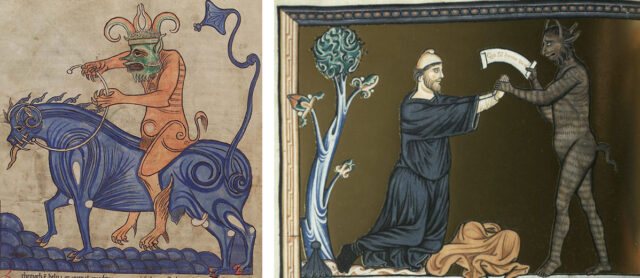

The episode of the fall of the angels was of particular interest to theologians and artists. The scholar Abbot Elfricus Grammaticus, who lived in the 10th century, suggested that God created not nine but ten ranks of these beings - and one of them was precisely the army of Satan who, because of his pride, betrayed the Creator. After this, artists began to paint one more "shelf" in heaven, representing the Lord's throne: the topmost was left empty in memory of the rebellious apostates who had been cast into the abysses of darkness.
Miniaturists often tried to show the transformation of the bodies of fallen angels. Therefore, in images where the army of Satan is cast down into hell, demons, just beginning their mournful path, absolutely identical to their former companions, throwing them down. Those who have already fallen from heaven grow horns, animal ears or clawed paws right in the air. And those who find themselves in the abyss have a more familiar appearance: black, unsightly, beast-like creatures.
In the twelfth century, Satan begins to mutate for the first time. One of the writings of the medieval intellectual Hildegard of Bingen describes her "vision of the Church as the Bride of the Son of God.
The devil emerges from the vulva of a woman (personification of the Church) standing in a prayerful pose.
From above she exudes a heavenly glow, with a crown on her head and a rich robe on her body. But on her feet are bruises denoting the suffering of the faithful. A devil with red eyes and sharp teeth emerges from her vulva. The fallen angel Lucifer utters, "My dominion shall come forth from the bosom of the Woman," referring to the Church. Thus the devil blasphemously imitates the Son of God. Having gained strength, he attacks the authority of the Lord Himself and is defeated. This image foreshadows the numerous countenances that grow on the body of Satan and his helpers, which will appear three centuries later.
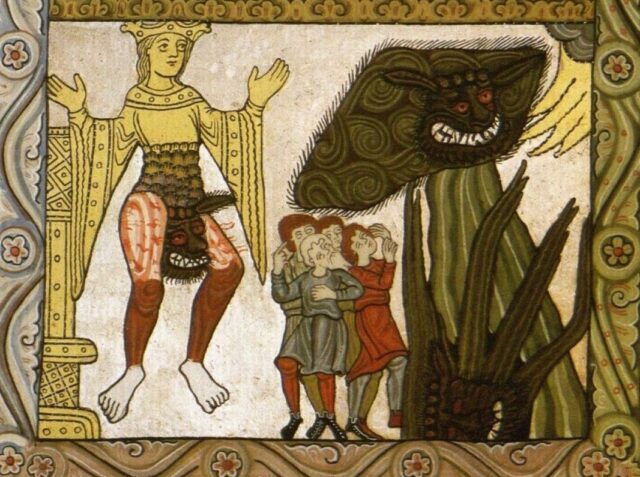

Varieties of angels and their meanings
The meaning of an angel tattoo depends on the type of celestial being depicted.
- Cherubs are golden-haired angel children depicted for protection and protection. They carry purity and innocence. And the image of Cupid (the most famous cherub) protects from suffering and unrequited love, gives strength to believe in a bright and tender feeling - love.
- Archangels are the angels closest to God, having the highest rank in heaven. They wage war and protect heaven from the forces of evil. The warrior angel depicted on the body represents the eternal struggle with unclean forces and evil, not only in the world, but also within themselves.
- Fallen angels are angels who have been cast out of heaven. They can choose what they do: good or evil. The image of these angels symbolizes the eternal struggle between good and evil.
- Lucifer is also a fallen angel, his image on the body reminds us of the insignificance of man before death, the transience of life.
- Fairy angels are frivolous and playful creatures that emphasize the lightness and innocence of the tattoo owner. These can be cartoon and fairy tale characters, as well as fairies and witches with wings.
- Angelic wings printed on the human body carry their own philosophy. The wide-spread wings talk about freedom and strength of spirit, about the closeness to heaven and God. If the wings are folded and wounded, a person has secret worries and insecurity. Wings on the back of a man speaks of strength and the ability to become a keeper of the hearth. Angelic wings on a woman emphasize her tenderness and femininity.
- Praying angel - this type of tattoo has its own special meaning. It is inscribed in memory of a lost loved one, of unceasing pain and grief. An angel will pray for all and he will surely be heard in heaven.
Sagging breasts and defecating sinners: the mutant devil
During the late Middle Ages, closer to the fifteenth century, the devil mutates at a terrifying rate. It is no longer a small black silhouette or a half-beast-half-man. Satan is increasingly losing his wings, as if to signify that he will never return to heaven. In their place he has chests with woolly nipples, bird feathers or tails, bushy eyebrows and ear hair, such as in the illustration from the Bavarian Bible of Otto Heinrich (around 1430).
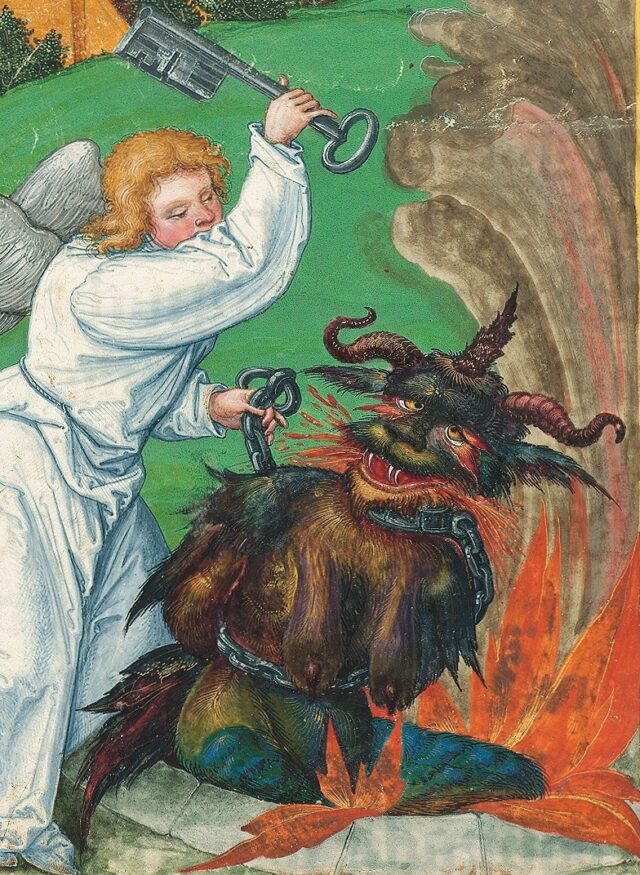

Satan is increasingly depicted as suffering - even as he torments sinners in hell, he himself is in torment. In a manuscript created in Catalonia in the 1430s and 50s, The Mirror of Human Salvation, the bound devil has two mouths: the second is in the crotch and, with a frozen grimace of horror, chews the resident of the underworld with his sharp fangs. Two more muzzles grow right out of his knees, and below are either bird's or toad's paws with long claws.
Such a composition was repeated in many paintings of the Last Judgment in European churches, such as the fresco in the Cathedral of Bologna, for which the artist Giovanni da Modena depicted the Muslim prophet Muhammad next to the devil among the sinners. Around his naked body is wrapped a snake, a symbol of vice.
Not so long ago, terrorist attacks aimed at destroying the controversial work were prevented, and Islamic radicals are relentless in their legal action to demand that the image be banned.
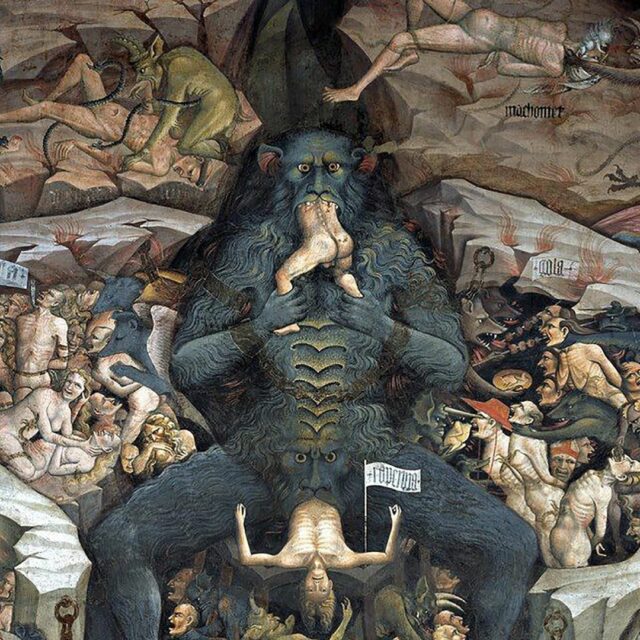

The bound Satan also appears on a miniature for the popular literary work The Vision of the Knight Tundal, created in 1475 in Ghent. The tree-like devil with hundreds of paws and branches is lying on a red-hot grid inside the mouth of the personified hell, suffering no less than the others, while a horny toad, a snake-tailed dog and a little devil are silently looking on from the threshold.
Such attention to images of Satan in the late Middle Ages is given because during this period famine and plague were raging across Europe, numerous Christian heresies were gaining more and more audiences, and Muslims were winning victory after victory. Apparently for the same reasons, theologians then often addressed the problem of active evil: the devil was not only waiting for sinful people, but also aggressively interfering in their lives, seeking to gain as many souls as possible.
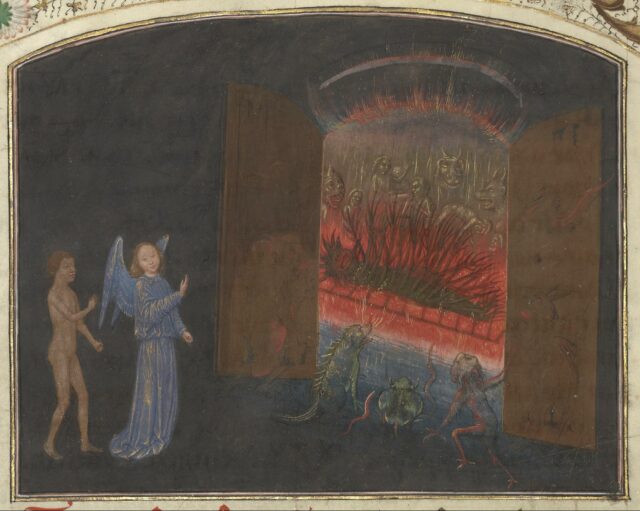

Demons
Appearance
Blaise is half angel half demon, so he has the traits of both. He has two wings, one angelic and one demonic. He has two wings, one angelic and one demonic. His ears are pointed and narrowed towards the top like most demons. He has brown eyes on his right and blue on his left. Has shoulder-length white hair with long bangs. Wears black clothes, which was left by his father.
Character
Blaise is kind and courteous, but when he gets mad it's better to keep your distance from him (It's from his father). Lazy and even very lazy. Can walk away from important decisions and battles . Although he has a temper, but with friends he is very caring(This is from his mother ).
Habits
He likes to smoke his father's pipe and wave his mother's fan around. Although he rarely does so in public.
Hobbies
He sings and likes to write poetry. Especially likes to write about unrequited love . So he collects fairy tales, that is, he likes to listen to all sorts of stories and fairy tales, and then write them down. He likes to dance with his famelear Alin. Also plays the violin very well.
Abilities
Can use the magic of combat and not a lot of knowledge heal. Can fly on wings, but does it very badly. He also plays the violin and reads poetry. His weapon is a fan inherited from his mother, which Blaise enchanted with a fiery cut. He has a family bat with heterochromia, whose name is Aline. He's also a lowly demon that can take human form. Very weak and can use magic on those who was bitten.
History
Blaise was born of a forbidden union between an Angel and a Demon. His father was of a famous demon clan, and his mother was an ordinary angel. But their love was hotter than all the heat of the underworld. But it didn't last long. Their secret marriage was discovered and both spouses were sent into exile. A month after the exile, the couple had a son, Blaise. The parents loved their child very much, but it all fell apart when they were found in the wanderings of the father's relatives, they killed both husband and wife, thanks to Blaise at that time, bathing on the river and no one found out about him. When the boy returned to the place where he slept he found his parents brutally murdered and screamed at the top of his lungs. His scream was heard for one kilometer. The demons that killed his parents were nearby, and when they heard the scream they understood that the marriage of their relative had a child, and he was now standing looking at the corpses of his parents. The demons had decided to finish with Blaise and to forget forever this unhappy couple, but when they came close to the place they saw that the boy had wings and his eyes shone with different colors. They were about to lynch the boy, but before they had time he let out a huge wave of energy in their direction, which had caused them mortal wounds and the entire group of demons died on the spot. After that day, Blaise became withdrawn and did not talk to anyone at all. Although there was one girl in his story, but she didn't last long with him either. The past few years Blaise wandered alone, and Alain he had enough of it, and he decided to start a new life pretending to be a normal weak demon half-blood and that not to give himself put a seal on himself controlling his power. Only two things can break the seal, a kiss on the lips or if the life of a half demon on the brink.
Three-faced and upside down: the Devil King.
In many medieval depictions, for example in a mid-15th-century French manuscript, we see a three-faced devil. In this way artists tried to show that the lord of evil parodies the Trinity itself. In iconography, this monster is not the triune God, but the Antichrist or devil, as indicated by numerous demonic attributes: his hair, which looks like tongues of flame, snakes in his hands, plants sticking out of his mouth, and so on.
In thirteenth-century French Moralized Bibles and later manuscripts, a three- or seven-faced Satan or Antichrist often sits on a throne, drawing a huge sword and his crown bristling with thorns, exposing the true nature of the unrighteous king. Because of the desire for rationalization, structure, and hierarchy, miniaturists paint a devil who reigns in the underworld as God does in heaven.
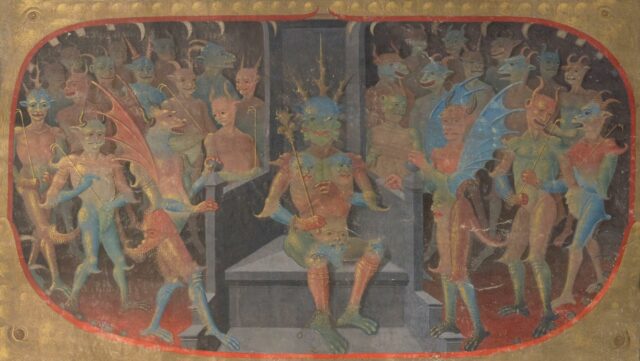

After the enormous success of Dante Alighieri's The Divine Comedy, completed around 1321, the chaotic universe of hell is streamlined. The underworld in iconography also begins to divide into distinct levels, ditches and crevices, and this hierarchy is completed by the figure of Satan standing upside down in the last circle of hell:
And I became speechless with amazement, When I saw three faces on him; One above his breast; His color was red; And above one and above the other shoulder Two adjacent to this to the side threatened, Conjoining at the back of his head beneath the crest. The face on the right was white and yellow; But the coloring on the left was As of those who came from the waterfalls of the Nile.
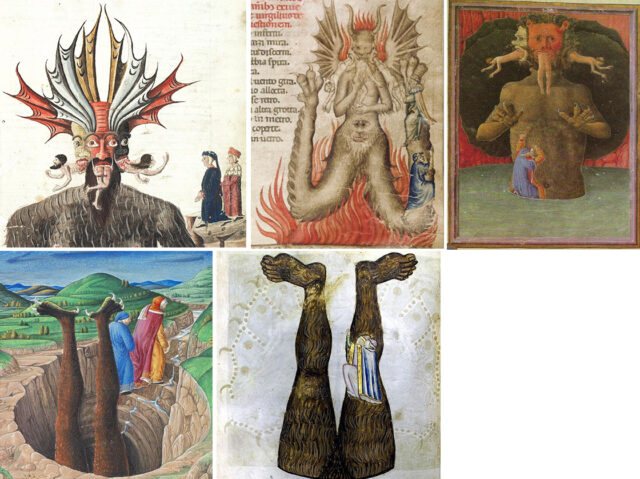

Divine messengers - the origin of the image
The word "angel" is of ancient Greek origin and means "messenger" or "messenger." Despite the fact that angels in the minds of modern people are associated exclusively with Christianity, the idea of the existence of intermediaries between the gods and mere mortals is rooted in antiquity.
Unseen protectors in ancient Mesopotamia
The concept of guardian spirits was popular in the religion of the inhabitants of ancient Mesopotamia-the Sumerians, the Akkadians, the Assyrians, and the Babylonians. They were called "shedu" or "lamassu" and looked like winged creatures with a human head and the body of a bull or a lion. The first images of these spirits date back to 3000 B.C. The prototype of lamasu was the Sumerian goddess protector Lammah, a mediator between the world of gods and men.
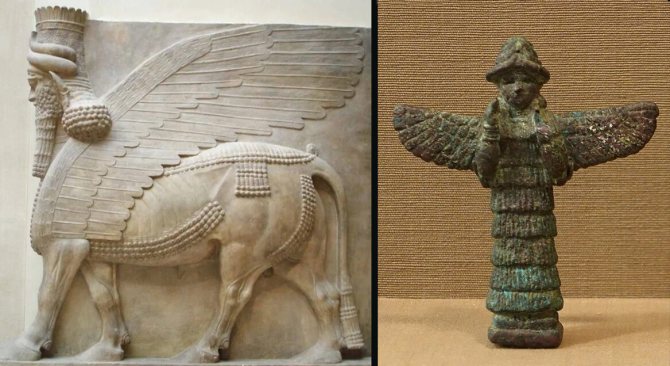

Huge guardian spirits served as gatekeepers to the temples and palaces of the rulers of ancient Mesopotamia. Their image is derived from the Sumerian goddess Lamma (right). Her raised hands symbolize a mortal's prayer to the gods.
The gods of ancient Greece are also somewhat angels.
Hellenistic culture had a tremendous influence on the art of the Mediterranean countries. It was in this region that the Christian faith originated, so echoes of the myths of ancient Greece penetrated the visual images of the new religion. The classic image of the angel - a winged young man or girl - echoes images of the ancient Greek god of love Eros (aka Cupid and Cupid) and the goddess of victory Nike (Victoria in the ancient Romans).
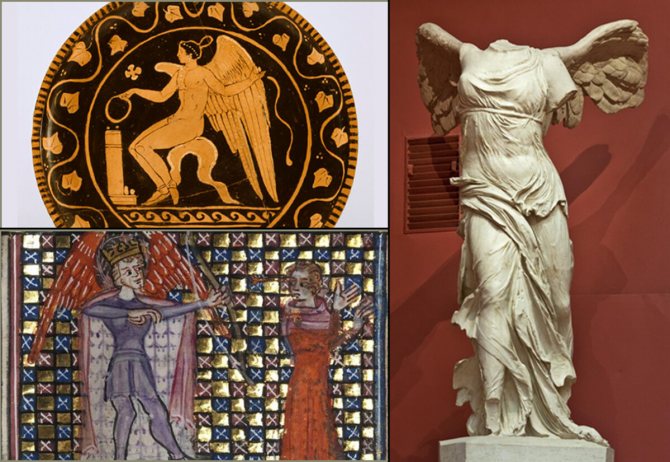

Cupid's wings symbolized the windy attraction and free will of lovers - they could always change their minds and "fly away" from each other. Nika used her wings to fly around the battlefield. They were also a symbol of her speed and strength.
Another representative of the pantheon of ancient Greece, Hermes, served as a guide to the will of the gods. Instead of wings, he used winged sandals.
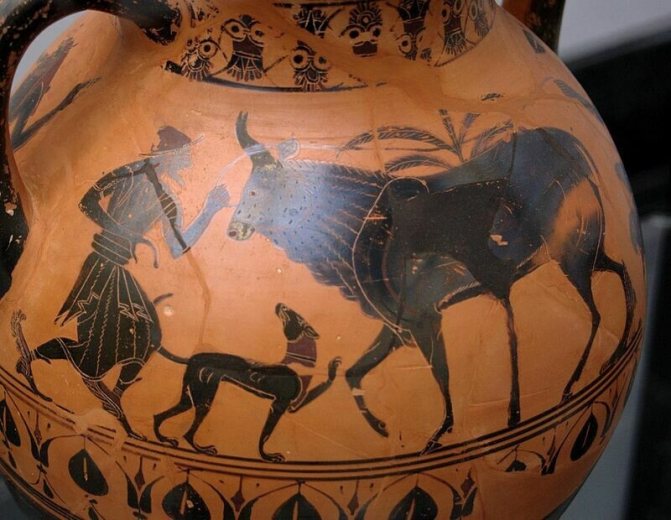

Hermes used winged sandals - thalarias - to bring news from Olympus.
Only the image of Cupid has retained great popularity to this day. It became a fixture in classical Western art, was popular in the Middle Ages and the Renaissance; it became a symbol of love and Valentine's Day.
The formation of the image of angels in Christian culture
Most modern people associate the word "angel" with a person of unearthly beauty in fluttering light clothing and with snow-white wings. However, the familiar image was not formed immediately.
How angels got wings
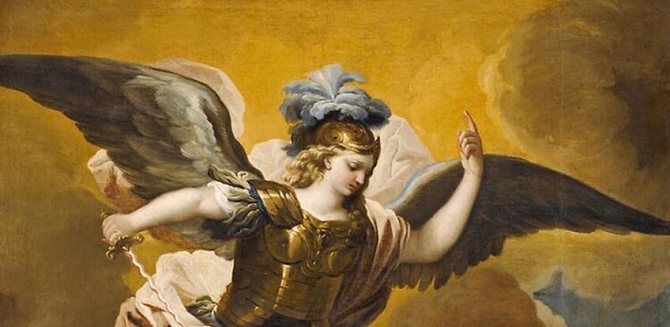

The most recognizable attribute of angels - wings - is not mentioned in any of the biblical texts.
In the canonical texts, God's messengers are described very sparingly, despite the fact that they actively interact with humanity. Angels are mentioned about 273 times in the Bible, but almost nowhere do they have wings. However, angels are unmistakably recognized by their shining robes and special aura of divine presence.
These same features of appearance are emphasized by the writers of the Gospels. Matthew, Luke, Mark, and John describe the angels as young men in snow-white robes, but they do not say a word about wings.
"Suddenly there was a great earthquake-the angel of the Lord came down from heaven, rolled away the stone, and sat on it. His face shone like lightning, his robes were white as snow."
Matthew's Gospel
It is possible that early Christian artists did not depict angels with wings to avoid confusion with pagan deities.
Tomb of Priscilla, 3rd century A.D. The Archangel Gabriel (right) informs the Virgin Mary of the future birth of the Savior. The figure of God's messenger does not differ from that of a mere human being.
The angelic appearance is described in more detail in the apocrypha of the Old Testament, and in particular in the book of Enoch. Although these texts are not the biblical canon, they have influenced the depiction of angels in the arts. According to Enoch, the angels were given wings to know the dimensions of Paradise. He also gives a detailed description of them in the Book of Mysteries.
"And there appeared to me two men so great as I had not seen before on earth. Their faces shone like the sun, their eyes exuded light, flames burst forth from their mouths. Their clothes flowed like sea foam, their wings were brighter than gold, and their hands were whiter than snow."
The Second Book of Enoch. The Book of Mysteries
A curious example of a change in the traditional canon in iconography is the mosaic on the triumphal arch of the Basilica of Santa Maria Maggiore. It shows the Virgin Mary seated on a throne surrounded by winged angels. During the restoration, a preparatory drawing - a synopia - was found under the mosaic. It depicted the angels without wings.
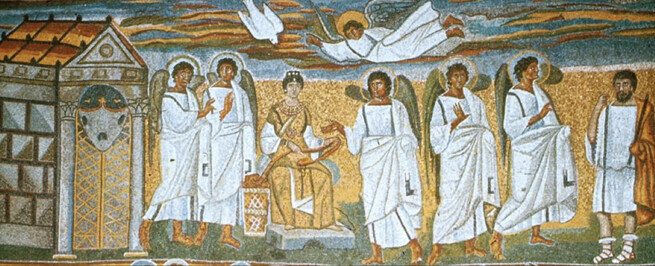

A mosaic of the Annunciation of the Virgin Mary, executed in 432 A.D., commissioned by Pope Sixtus III. In the original sketch, the angels had no wings.
You can read more about how the angels got their wings here.
On the question of gender
Theologians define angels as beings of spiritual matter who do not eat, sweat, or have gender. Nevertheless, these canons have not always been followed in the visual arts.
In the Old Testament, angels are described as men, called "sons of God. Their attraction to human women led to the birth of the giants Nephalim and the Great Flood.
"When men began to multiply on the earth and daughters were born to them, then the sons of God saw the daughters of men, that they were beautiful, and took them for wives, whichever one chose."
The Book of Genesis
The masculine description of angels is reinforced by the image of the archangel Michael in the Roman tomb complex of the Via Latina of the second century A.D. The angel who appeared to the prophet Balaam was bearded. It is possible that the reason for this is the low authority of women in the society of that time. The messenger of God represents part of his power and strength and, according to early Christian artists, must necessarily be a man.
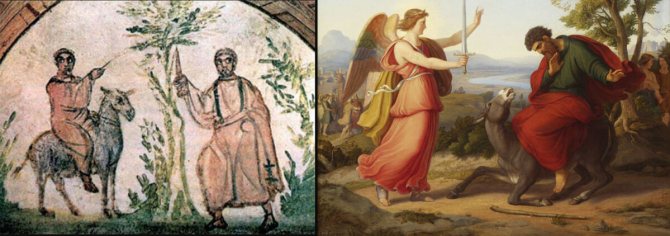

The same subject with a difference of 17 centuries. The angel became androgynous and acquired wings.
As religious thought progressed, the concept of the messengers of God became clearer, and they lost their pronounced sexual characteristics - beard, chest, coarse facial features. Artists respected the church canon until the 19th century and depicted angels as sexless beings.
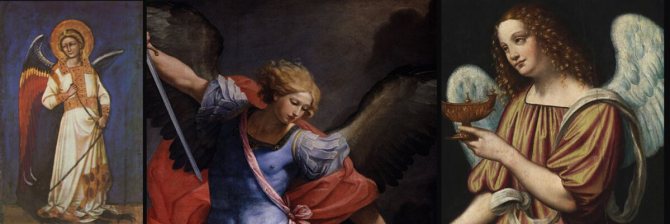

Androgyny became a reflection of their spiritual essence - these beings are devoid of original sin.
The traditional rule began to be ignored in the 19th century, especially in the design of places of burial. The image of the angel-woman successfully combined with the image of the mourner.
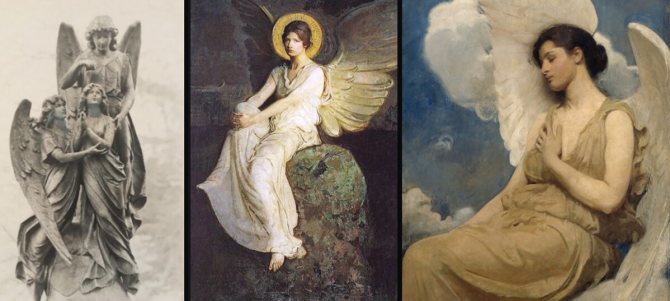

Since the 19th century women angels appeared in art.
The nimbus - visible holiness
Angels and saints in Christianity are often depicted with a shining halo over their heads. It symbolizes the divine radiance and holiness emanating from them. This expressive technique was invented long before Christian artists. Light in the form of a circle at the head accompanied the pagan sun gods, rulers and heroes of antiquity.


In the solar gods, the halo above the head was a personification of the solar disk and the divine radiance, and in the case of the august personalities, a reflection of their high status. Ra (left), Helios (center), profile of King Ptolemy III.
Nimbuses did not appear in Christian art until the fourth century A.D. They were originally depicted as a simple circle within which the head was inscribed. As traditions in the fine arts changed, the problem of depicting the nimbus in perspective appeared. It began to be depicted as a flat disc attached to the vertex or as a shining circle similar to a diadem. Some artists literally interpreted the meaning of the word "halo" and painted angels with a golden glow around their heads.
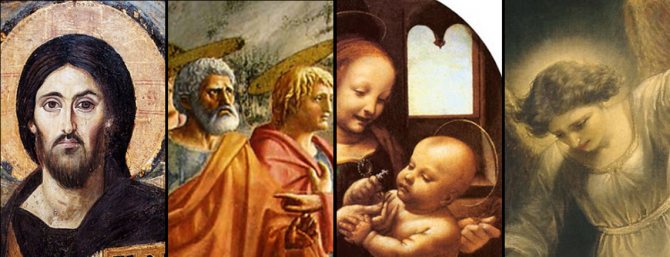

Artists have been experimenting for centuries with depictions of the glow that surrounds angels and saints.
Tongue in crotch and inconspicuous horns: the monster devil and the trick devil
The late medieval devil is becoming increasingly exoticized and grotesque. Satan's henchmen of many colors (sometimes all at once) and shapes are not far behind.
Their horns not only grow on their heads, but also on their butts, their tongues grow out of their crotches, and they have unimaginably large polecats on their tops.


The devil is beginning to be portrayed more often among the people. He penetrates everywhere, even in the homes of the saints, preaching in churches and trying in every way to win mankind to his side, by himself or with the help of his minions and the Antichrist. His insidiousness is so great that he cleverly hides behind different guises, and his hellish nature is sometimes revealed only by his tail or bird's paw sticking out inadvertently from under the floor.
Often, however, artists painted the Devil without any cuts, meaning that the people around him could not see his true essence. For example, in the mid-15th-century altarpiece by Italian artist Antonio Vivarini, St. Peter the Martyr casts out a demon who has taken on the image of the Madonna and Child or who has taken up residence in their statue. We can clearly see the devil's tail, horns and wings, but it was implied that the people standing in the church cannot see Satan's wiles.


An early 16th century fresco by Luca Signorelli in a church in Orvieto shows the devil whispering a sermon to the Antichrist.
His portrait resemblance to Jesus is not accidental: he had to imitate all the acts of the Messiah, including his death and resurrection, so that people would believe him and leave the true path.
However, the false prophet is distinguished by demonic features: the curls unmistakably suggest horns. Also, the Antichrist is dressed in yellow, and in medieval iconography, outfits of this color were usually "worn" by the main enemies: Jews, Muslims and Judas. Some art historians believe that Luca Signorelli portrayed the Italian reformist monk Savonarola as Satan.
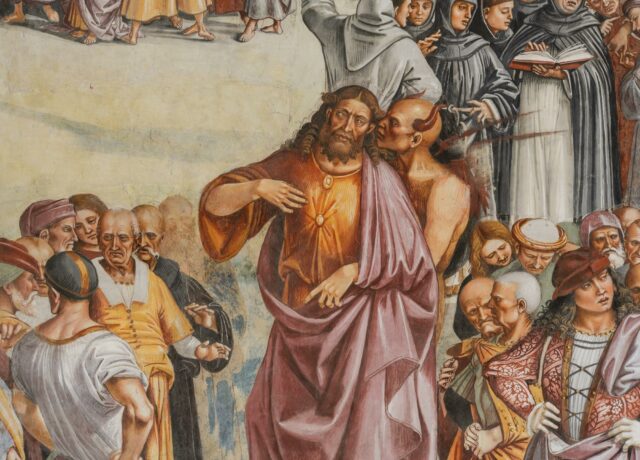

Grotesque hybrids: the devil of the old masters
Influenced by frescoes, altarpieces, and miniatures, the famous artists Hans Memling, Jan van Eyck, Hieronymus Bosch, Peter Bruegel, and others began to portray Satan in the same, grotesque and baroque fashion. Assembled from many heterogeneous body parts, this character becomes more ridiculous than scary or majestic.
Memling's Devil, painted around 1485, is on the polyptych at the left hand of the Lord. It is as if he is dancing with his bird's paws on sinners baked in the jaws of a personified hell, his hands strewn with numerous thorns and claws, and a second face looking directly at the viewer from his belly.
Van Eyck's Crucifixion and the Last Judgment (1430) shows Death as a winged skeleton, which literally defecates sinners in Gehenna fire, where demons of all stripes await them. It is difficult to see a central figure among them, but the one on the left is noticeably larger than the others - most likely this is Satan. His body resembles the carcass of a dragon, with antlers growing out of his head and flames bursting from his mouth.
Hieronymus Bosch's Devil from the triptych The Garden of Earthly Delights (1510) is even more exotic: executed in late medieval fashion, he resembles a hybrid of a bird, a goat and a chubby man.
The soul-eating Satan sits on a "toilet bowl" throne and defecates sinners.
Naked loins: the romantic devil
The evolution of the devil ended where it began. After the publication in 1667 of English writer John Milton's poem Paradise Lost, which detailed the story of the confrontation between Satan and God, the image of the unclean began to be romanticized. He is again beginning to be portrayed as an angel, usually a muscular and extremely pleasing man, without any grotesque elements. It is no longer a hybrid or a monster. However, a characteristic detail - horns or wings - sometimes gives away the devil in the handsome man.
One of the sexiest images of Satan was created in 1842 by the Belgian sculptor Joseph Gefs for the cathedral in Liege. His "Genius of Evil" was a naked young man with bat wings.
The devil turned out to be so beautiful that the local bishop asked that the statue be removed from the church. Newspapers trumpeted that such a Satan could distract young girls from prayer and sermons.
In 1848 Joseph Gefs's brother Guillaume produced another image of the lord of the underworld to replace the too beautiful sculpture in the cathedral of Liège. His Satan weeps, the serpent is replaced by a biting apple, the character is more muscular and less young, and his loins are hidden under a veil so as not to embarrass parishioners. A chain is attached to his leg, and he is chained to a rock. If you look closely at the hair, you can see small horns. The bishop, having carefully inspected the work, accepted the sculpture, which to this day adorns the Cathedral of Liège.
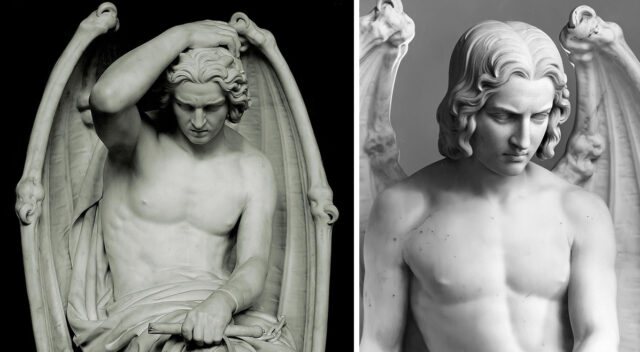

In 1847, the French artist Alexandre Cabanel paints a picture of the Fallen Angel. On it, Satan is again depicted as a man with a luxurious body, and the traditional bat wings are replaced by bird wings, which brings this figure even closer to the image of the heavenly messenger.
In 1866, Gustave Doré made engravings for a work by John Milton: the devil is as majestic as his pious brethren, differing from them only in the shape of his wings and the color.
In 1885, Ricardo Belvera's sumptuous Fallen Angel fountain appears in Madrid. Prior to that, the statue had received many awards and was exhibited for some time in the Museo del Prado. Belvera's devil is obscenely nude, with a snake wrapped around his ankle and wrist and bird's wings protruding from his shoulders.
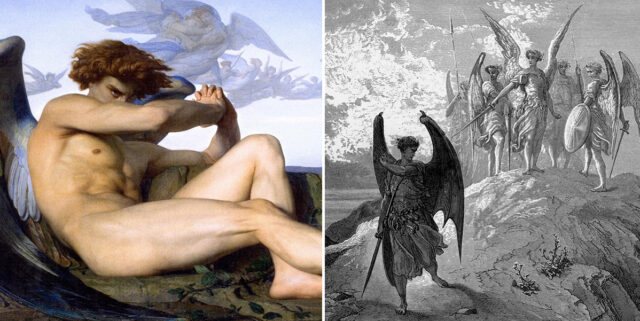

The German painter Franz von Stuck painted a darker and more mysterious Satan in an 1890 painting: his wings are of black feathers and his eyes seem to glow from within with the flames of hell.
The devil in Sascha Schneider's Triumph of Darkness (1896) is muscular, bearded, and almost completely naked. The artist shared the ideas of naturism, whose representatives called for being in the bosom of nature without clothes and extolled the cult of health and physical strength in art.
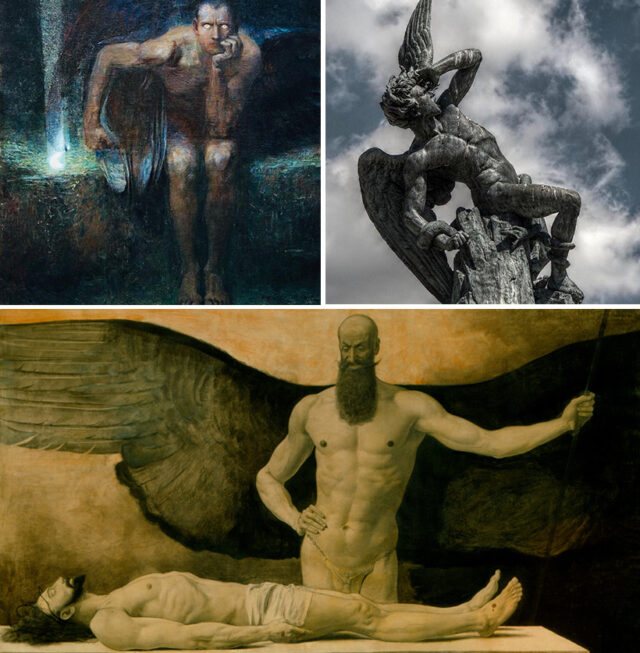

Following painting, romantic tricksters also appear in literature. Mephistopheles and Woland finally establish a new type of Satan - a demonically attractive man. Thus the devil, portrayed in Antiquity as a cherub, in the Middle Ages as a beast, a pan-shaped monster or a grotesque and ridiculous hybrid with his face on his ass, has once again become a majestic angel.
